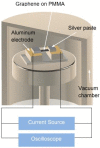Review on Techniques for Thermal Characterization of Graphene and Related 2D Materials
- PMID: 34835552
- PMCID: PMC8617913
- DOI: 10.3390/nano11112787
Review on Techniques for Thermal Characterization of Graphene and Related 2D Materials
Abstract
The discovery of graphene and its analog, such as MoS2, has boosted research. The thermal transport in 2D materials gains much of the interest, especially when graphene has high thermal conductivity. However, the thermal properties of 2D materials obtained from experiments have large discrepancies. For example, the thermal conductivity of single layer suspended graphene obtained by experiments spans over a large range: 1100-5000 W/m·K. Apart from the different graphene quality in experiments, the thermal characterization methods play an important role in the observed large deviation of experimental data. Here we provide a critical review of the widely used thermal characterization techniques: the optothermal Raman technique and the micro-bridge method. The critical issues in the two methods are carefully revised and discussed in great depth. Furthermore, improvements in Raman-based techniques to investigate the energy transport in 2D materials are discussed.
Keywords: 2D materials; optothermal Raman technique; thermal transport.
Conflict of interest statement
The authors declare no conflict of interest.
Figures




Similar articles
-
Methods for Measuring Thermal Conductivity of Two-Dimensional Materials: A Review.Nanomaterials (Basel). 2022 Feb 9;12(4):589. doi: 10.3390/nano12040589. Nanomaterials (Basel). 2022. PMID: 35214918 Free PMC article. Review.
-
Measurement of Lateral and Interfacial Thermal Conductivity of Single- and Bilayer MoS2 and MoSe2 Using Refined Optothermal Raman Technique.ACS Appl Mater Interfaces. 2015 Nov 25;7(46):25923-9. doi: 10.1021/acsami.5b08580. Epub 2015 Nov 10. ACS Appl Mater Interfaces. 2015. PMID: 26517143
-
Thermal transport across wrinkles in few-layer graphene stacks.Nanoscale Adv. 2021 Jan 13;3(6):1708-1716. doi: 10.1039/d0na00944j. eCollection 2021 Mar 23. Nanoscale Adv. 2021. PMID: 36132551 Free PMC article.
-
Measurement of specific heat and thermal conductivity of supported and suspended graphene by a comprehensive Raman optothermal method.Nanoscale. 2017 Aug 3;9(30):10784-10793. doi: 10.1039/c7nr01695f. Nanoscale. 2017. PMID: 28726940
-
Critical problems faced in Raman-based energy transport characterization of nanomaterials.Phys Chem Chem Phys. 2022 Sep 28;24(37):22390-22404. doi: 10.1039/d2cp02126a. Phys Chem Chem Phys. 2022. PMID: 35942687 Review.
Cited by
-
Perspectives on Energy Transport at the Micro/Nanoscale.Nanomaterials (Basel). 2023 May 26;13(11):1746. doi: 10.3390/nano13111746. Nanomaterials (Basel). 2023. PMID: 37299649 Free PMC article.
-
Methods for Measuring Thermal Conductivity of Two-Dimensional Materials: A Review.Nanomaterials (Basel). 2022 Feb 9;12(4):589. doi: 10.3390/nano12040589. Nanomaterials (Basel). 2022. PMID: 35214918 Free PMC article. Review.
-
Temperature Dependence of Thermal Conductivity of Giant-Scale Supported Monolayer Graphene.Nanomaterials (Basel). 2022 Aug 15;12(16):2799. doi: 10.3390/nano12162799. Nanomaterials (Basel). 2022. PMID: 36014664 Free PMC article.
-
Remarkable Thermal Performance Enhancement of Micro Heat Pipes with Graphene-Nanoplatelet Nano-Wicks.Nanomaterials (Basel). 2023 Jan 4;13(2):232. doi: 10.3390/nano13020232. Nanomaterials (Basel). 2023. PMID: 36677986 Free PMC article.
References
-
- Ahmadi Z., Yakupoglu B., Azam N., Elafandi S., Mahjouri-Samani M. Self-limiting laser crystallization and direct writing of 2D materials. Int. J. Extreme Manuf. 2019;1:015001. doi: 10.1088/2631-7990/ab0edc. - DOI
Publication types
Grants and funding
LinkOut - more resources
Full Text Sources
Other Literature Sources

